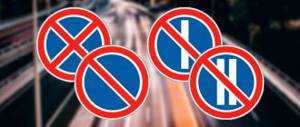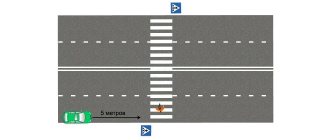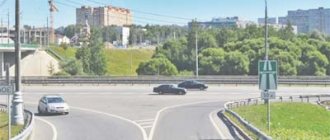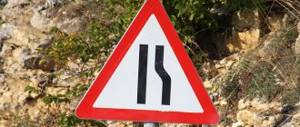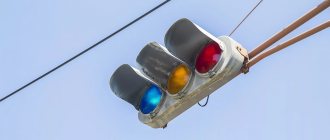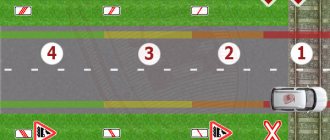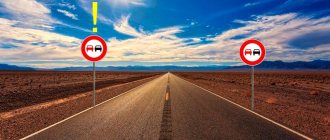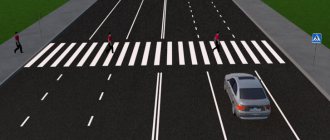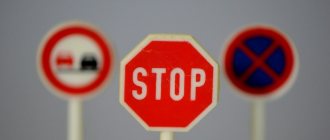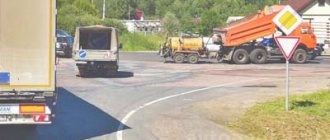What are noise stripes
Since this phenomenon on the roads is new to the Russian driver, you need to familiarize yourself with it in more detail. Noise strips are positioned as a cheaper alternative to speed bumps, the price of which is close to 200,000 rubles. This is quite a significant amount, especially for large cities with developed road infrastructure. The noise strip performs the same functions as a speed bump , but it is an order of magnitude cheaper.
What is the purpose
The function of the noise strip is simple - to force the driver to reduce speed and sharpen attention on a certain section of the road. This is achieved by applying stripes to the surface with a changed height relative to the road surface. As a result, the tires make a sound when they hit the markings, which the driver immediately pays attention to. The advantage of this invention is that, unlike the already familiar “speed bump”, it does not destroy the car’s suspension.
Application area
It is used in the same places where speed bumps were previously installed, on roads of increased danger for pedestrians and drivers themselves. Usually these are sections of the road with a reduced speed limit. For example, in front of children's institutions, schools, clinics, kindergartens, or before a sharp turn, a railway crossing, a sharp descent or ascent.
Right-of-way dimensions
There are certain rules for establishing the boundaries of right of way. They are contained in Order of the Ministry of Transport of the Russian Federation dated 08/06/2008 N 126 “On approval of the Norms for the allocation of land plots necessary for the formation of the right-of-way of railways, as well as the norms for calculating security zones of railways.” Let's look at this issue in detail.
The width of right-of-way is determined differently for land plots:
- With an embankment height of up to 12 m;
- With a recess up to 12 m deep;
- With special natural conditions of the area.
For the first two points, the width of the right of way is established on the basis of tables in which the main parameters affecting the width are the category of the railway track, the slope of the terrain, the height of the embankment/the depth of the excavation. The category of a railway line is determined based on its purpose, volume of cargo transportation, speed of passenger trains, etc. What categories there are and how they are determined, including those appearing in the order of the Ministry of Transport of categories I – IV, can be found in “SP [set of rules] 119.13330.2017 1520 mm gauge railways.” Thus, for a railway road of category III with a cross slope of 1:7 and an embankment height of 6 m, the width of the right of way will be 37 m. Knowing the parameters, it is quite simple to determine the width of the right of way using the table. But there are some nuances depending on the characteristics of the railway. Thus, to accommodate embankments made of certain types of soil (rock, draining sand), the width of the right of way can be reduced by 1 meter. If railway tracks of categories I and II are located on lands not suitable for agriculture, then another 10 m is added to the width from the table.
To determine the width of the right of way on land plots that differ in various natural features (for example, located in permafrost areas, in swampy areas, near reservoirs, on landslides, etc.), you need to look at Table 3 of the order of the Ministry of Transport. In it, the width of the right of way depends on how often natural phenomena adversely affecting the railway infrastructure occur. If, according to Table 3, the width of the right-of-way is greater than that established in the two tables discussed earlier, then the additional part of the strip (that is, the one that exceeds the size established in Tables 1 and 2) is allocated to the railway security zone (about which you can read in our independent material). Let's explain with an example. Let’s say the railway runs through an area in which the frequency of ravine formation is once every 10 years. At this frequency, the width of the right of way is 60 m. At the same time, for a category II railway track, the height of the embankment is 3 meters with a transverse slope of the terrain of 1:10. According to Table 1, the width of the right of way will be 27 m. Since the right of way, taking into account the natural features of the site, is 33 m larger, this part of the territory should be considered a security zone, and not a right of way. Using a special formula, the width of the right of way is calculated if it contains forest plantations that prevent snow from melting. If the railway runs through an area covered with stoves, then the right of way in this case will be fixed: at least 200 m - in desert and semi-desert areas; at least 100 m - in other areas.
In this case, it is necessary to take into account the norms not only established in the considered Order of the Ministry of Transport, but also the norms of land management, urban planning and design documentation, general schemes for the development of railway lines, junctions and stations, etc.
Classification
There are many purposes for installing noise strips, which is why a special classification has emerged based on the type and method of their arrangement:
- Transverse. They are applied to the road surface crosswise - from one edge to the other. They are made with a slight bias towards the movement of cars, so that the wheel rolls over them smoothly, without impact. The height of such markings should not exceed 10 mm, the average height is 5 mm.
- Longitudinal. They are applied along the road surface, representing a dividing strip in the middle of the road or limiting the edge of the road surface closer to the side of the road.
- Regional Designed to warn the driver about leaving the edge of the road to the side of the road. Apply directly to the edge of the road surface.
- Axial. Represent the dividing strip. Its purpose is to warn the driver about entering oncoming traffic.
World application experience
In countries that practice noise striping, accident rates have decreased significantly. For example, in the USA, accident rates on such highways have decreased by 85%. The reason for this result is that in this country the transportation of goods by road is extremely widely developed. Now heavy truck drivers do not fall asleep on the roads while driving for 10-12 hours at a time. Noise strips prevent trucks from leaving the road or driving into oncoming traffic.
The same effect is observed in Japan, where the appearance of noise strips on the roads has reduced the accident rate by 55%. In this case, the country is smaller compared to America, but it also has a lot of traffic on its regional routes.
A positive trend towards reducing road accidents is observed in European countries - Denmark, Sweden and Finland.
This trend is encouraging other countries to also use noise strips on their roads, which has a positive effect on reducing the number of accidents.
Types and methods of application
Technology and material are selected depending on the tasks and purpose:
- Thermoplastic. This material is durable, adheres well to asphalt, and when tires hit it, it makes them sound much louder. This material is applied in blocks of 5 stripes at a time, 10 cm wide. Sometimes there are 4 elements in a block, 15 cm wide. In some cases, thermoplastic is applied in small, even drops arranged in a line of a given width and length. To make thermoplastic more visible on the road, it is painted yellow.
- Anti-slip coating. This material is a high friction paint. It is also applied in blocks of several lines 5 cm wide and the length required to completely cover the road surface.
- Road milling. This sound strip is obtained by sampling a part of the road surface using an industrial cutter. The equipment is installed on a special machine and the cutter is adjusted in such a way as to remove 10-20 mm of the top asphalt coating in areas 20-40 cm wide and 10-20 cm long. The result is an outwardly invisible strip of small holes across or along the road surface. When hit, the tires change their sound. The advantage is durability and external invisibility, so it is used where additional road markings are not needed at all or will interfere with drivers.
- Noise strip made of metal brackets. Such an element is installed on a road surface made of high-strength concrete. The brackets are recessed into the concrete at the stage of its installation, representing a line of small rectangular or round elements. Paint and thermoplastic do not adhere well to concrete surfaces, so milling or metal clamps are more appropriate.
- Light and noise strip. This combined marking is used on autobahns in Germany and other European countries. It consists of small metal rectangles with a reflective element on the surface. The bracket is attached to the road surface in such a way that it rises by approximately 5-7 mm. When hitting it, a characteristic hum and vibration is heard. In the dark, such a strip perfectly reflects light, making markings on the road visible. Such devices are usually used to mark a median on a road.
- Some US roads have music stripes. In this case, the plastic markings are applied in such a way that when a wheel hits it, the noise changes its tone. That is, one strip is 1-2 mm higher than the other, but this is enough to cause a simple melody by the hum of the tires. This works especially well if the markings are made of small plastic droplets. This effect is so unexpected that the driver who has dozed off behind the wheel instantly wakes up.
Driving in lanes when changing lanes
Changing from one lane to another before making a maneuver or crossing is a big challenge for some. After all, there is a danger of colliding with another car. In the traffic rules, lane movement and lane changes are regulated by clauses 8 and 9:
- If one car was driving and continues to move straight, and the second intends to turn, it is obliged to give way to the first. And only after that can it shift to the outer lane.
- Sometimes both cars are about to make a maneuver. This means that what is to the right of another vehicle has an advantage. First, this car is rebuilt, only after it the opponent performs the maneuver.
The rules apply regardless of whether the lanes are separated from each other by markings, or whether drivers have to determine them “by eye.” You just need to remember that without a dividing line, only an even number of them is possible (2, 4, but not 3).
More on AutoLex.Net:
Where and what type of traffic stop sign is placed, types of road signs, how the driver is allowed to act at the sign 5.16
It’s more difficult when both cars are driving in the same lane and are about to change lanes at the same time. Here it is important to turn on the turn signal in time so that road users understand each other’s intentions, monitor the road with the help of mirrors and choose the right speed.
Watch this video on how to change lanes correctly:
Band requirements
On Russian roads, noise stripes appear in accordance with GOST R52605-2006. They are applied along or across a canvas no less than 7 m wide. In the second case, the marking consists of 5-8 lines 10-15 cm wide, made of thermoplastic or by milling.
The choice of location is based on the accident rate of the road section, the presence of childcare facilities, the complexity of the intersection and a number of other characteristics. The decision to install a noise strip rests with the head of the district through which the road passes.
There are places on roads and highways where the installation of noise strips is not permitted:
| Did not find an answer to your question? Call a lawyer! Moscow: +7 (499) 110-89-42 St. Petersburg: +7 (812) 385-56-34 Russia: +7 (499) 755-96-84 |
- bridges and overpasses, as well as sections of the road approaching them. The fact is that vibration of the road surface can cause resonant excitation and, as a result, destroy supporting structures;
- in areas of narrowing of the road surface;
- on a section of road 2 lanes wide, if overtaking is allowed on it;
- sections of the route at the junction of secondary roads or intersections with them;
- in the immediate vicinity of an intersection, especially after passing it. The minimum distance for the beginning of the noise strip after the intersection is 10 m;
- on roads with noise restrictions. The exception is tracks equipped with sound barriers in the form of fences and special shields.
In general, noise strips are liked by both drivers and organizations tasked with maintaining the road surface in working order. Their installation does not require blocking traffic and expending large resources. At the same time, the impact on the driving performance of the car, its components and mechanisms is minimal.
Traffic signs driving in lanes
Sometimes traffic rules signs make driving in lanes clearer and simpler, in other cases they make it more complicated. Problems arise more likely from those who do not know how to read them. What symbols can be used:
- 5.15.1. Indicates which of several lanes you can drive from it to the right, straight and to the left, from where you can turn around. The direction is easy to understand by the arrows.
- 5.15.2. There are several of these symbols. And each indicates one or two permitted directions. If the symbol is on the leftmost lane, it allows a turn in the same direction, under it you can change the trajectory by 180 degrees.
- 5.15.3. Shows the starting point of a new row for cars. The latter may be intended for braking or begin on an ascent. The symbol indicates an additional lane; traffic regulations require it to be used in different ways.
More on AutoLex.Net:
Important traffic rules priority signs and rules for reading them
If there is a speed limit on it, you cannot drive faster from here to the end of the coverage area. This usually happens in the braking zone. First they change lanes, only then reduce speed. If we are talking about an acceleration lane, they speed up the car on it, change lanes to the next one, not forgetting to let those who were already driving there pass.
- 5.15.4. It means the same as the previous symbol, but is installed where the central stripe begins (and there are two more on the sides).
- 5.15.5. Completes the acceleration section or climb.
- 5.15.6. It is installed where the central part of a three-lane road disappears.
- 5.15.7. Indicates which direction the movement is directed, and is necessary if there are more paths leading into one of them than towards them.
- 5.15.8. Shows the number of lanes and the speed limit for each.
The symbols may not be observed by public transport, but they are mandatory for everyone else.

